D16 Group’s Nepheton 2 breathes exciting new life into a drum machine legend
You may think you’ve heard it all before, but excellent new features add surprising versatility to D16’s updated drum machine
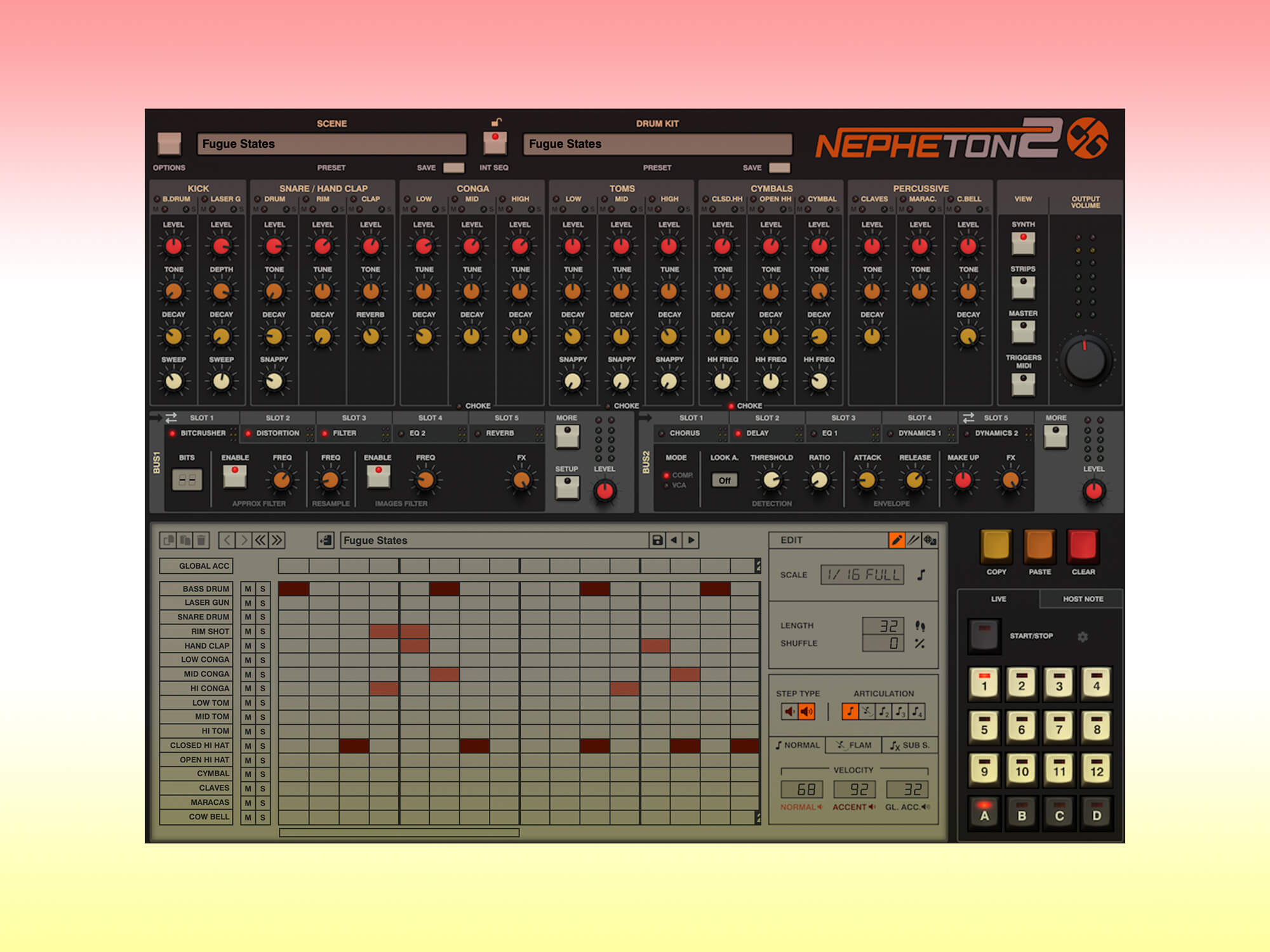
D16 Group’s Nepheton 2
Review Overview
Our rating
8
Our verdict
⊕ Improved sequencer is quick and easy to program
⊕ Superb effects vastly increase versatility and create a fat, polished sound
⊕ Effects routing is incredibly flexible
⊖ Can’t tune the pitch of the kick drum
⊖ No separate presets for effects busses
⊖ No gain reduction meter on dynamics modules
⊖ Can be quite complex
€119, d16.pl
Following a refresh of its 909 and 303 plugins, it’s no surprise to see D16 Group divert its attention to updating Nepheton; an emulation of the iconic 808 drum machine.
You only have to search the Internet for 808 sample packs and software instruments to see that the sound of Roland’s classic is a well-trodden path. But Nepheton 2 manages to cover new ground, largely thanks to a superb new effects section. Other new features include separate channel strips for each sound and a greatly improved step sequencer. Is this finally the one 808 to rule them all?
How does the Nepheton 2 sound?
The main sound sources include the familiar 16 synthesised percussion sounds, plus an extra zappy kick drum called Lazer Gun.
The Synth tab shows simple controls for each, including a mix of Tone, Decay, Tune and Snappy dials, plus a few extras relevant to each individual sound. It goes beyond what’s offered on the original Roland TR-808, and also what’s often found on most virtual 808 instruments, so off the bat you have more control for refining your sound.
D16 should be praised for offering up this extra editing power, but it missed a trick by not letting you freely tune the kick drum or some of the other sounds. Yes, it’s more authentic to the original, but if you could pitch the kick (in particular) up and down more, then it would be easier to get it to sit in the mix and fit the key of your track.
To refine things further, a Strips tab presents channel strips for each sound. This gives you resonant low cut and high cut filters, two bands of EQ, a compressor with lookahead, and Pan, Spread, and Level controls. It’s worth noting that although the Spread effect sounds nice, it’s merely a simple Haas delay that could cause issues when collapsed to mono.
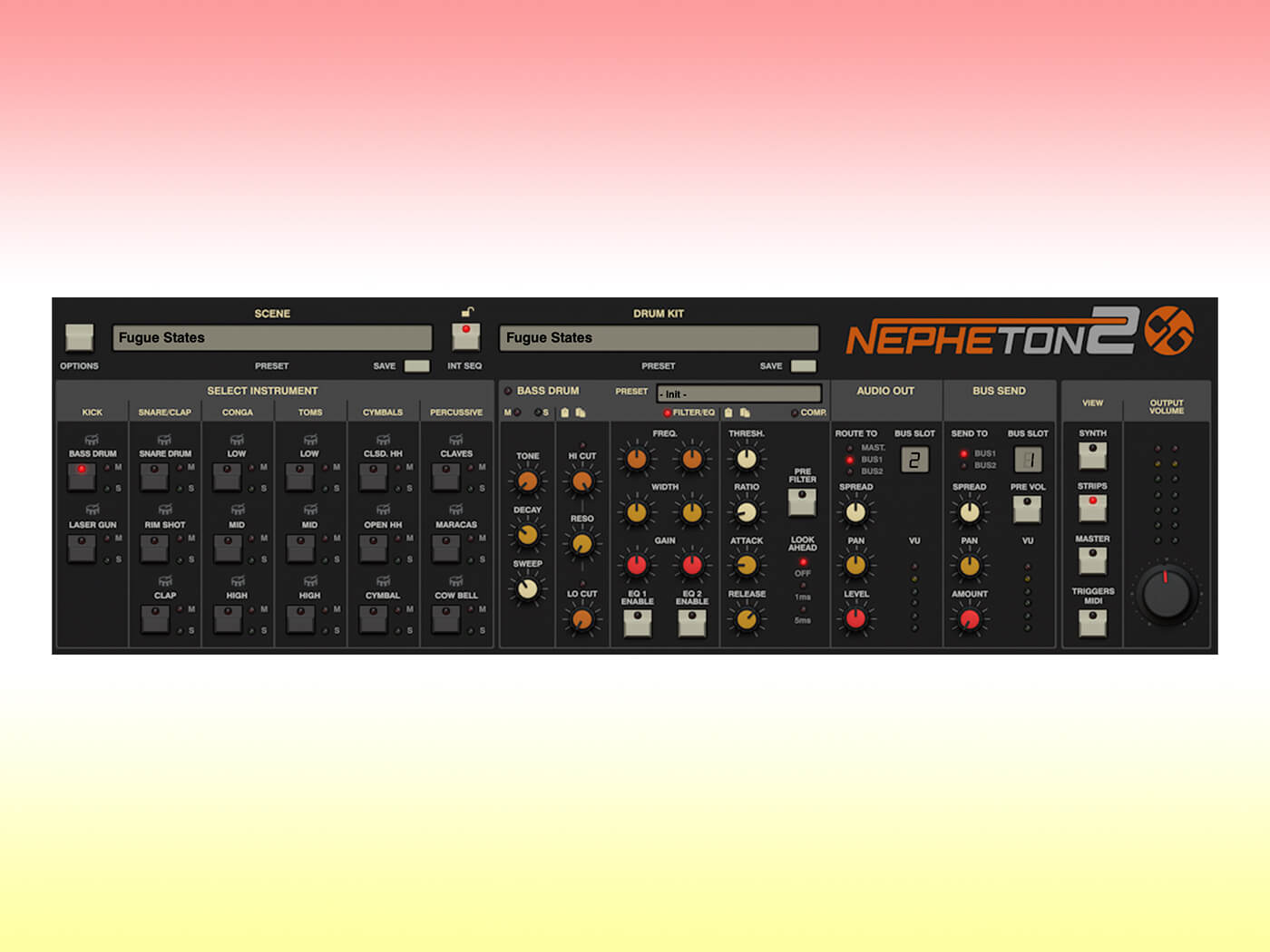
What effects does the Nepheton 2 have?
This brings us on to the routing and effects, which are what really helps to set Nepheton apart from its competition.
There are two effects buses with five slots in each, and options for distortion, bitcrush, chorus, delay, reverb, filter, and two modules for EQs and dynamics.
D16 is known for its excellent sounding effects, and these processors don’t disappoint. The distortion in particular is wonderful and can go from subtle, warming harmonics through to out-and-out destruction. It also has a frequency split feature, so you can leave the low-end alone and only saturate the highs.
Other notable features include side chains in the Dynamics and Filter modules that can take their input from any internal sound, extended parameters such as dither and jitter for flexible editing of the bitcrusher, and modulation on reverb tails. The only disappointment here is that the layouts are quite simple, with little visual feedback — you can’t see if or how the Dynamics modules are compressing, for example.
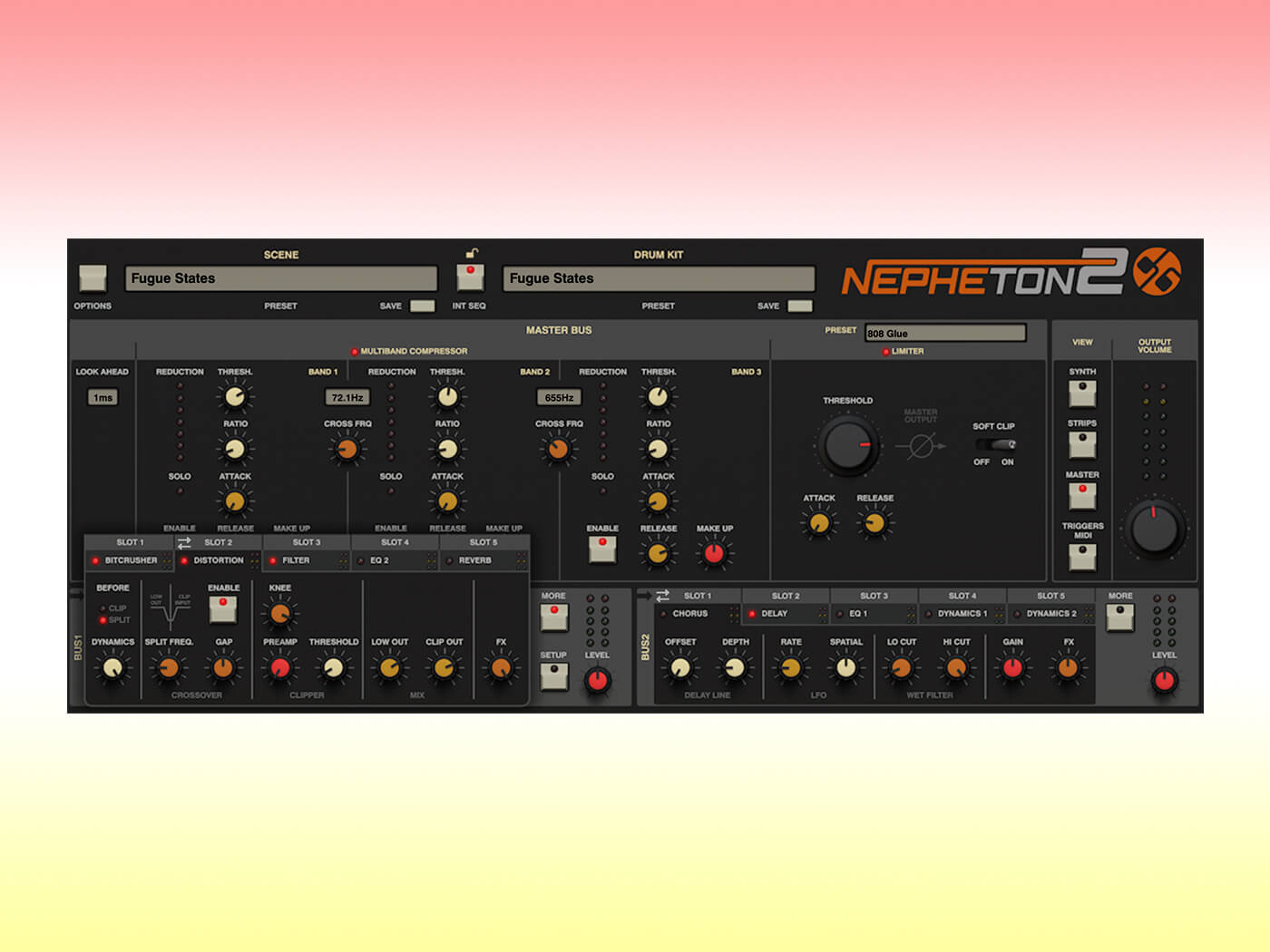
Bus routes
Routing to effects is incredibly flexible. You can choose to route the outputs directly to bus 1 or 2, or you can direct a portion of the sound as a send. Not only that, but you can choose where in the chain you want your signal to go, so you could have a booming kick going through a distortion in slot 1 while you have a softer clave sound go through a reverb in slot 5. As the chain runs in serial, this would mean the clave avoids the distortion.
To further add to the brain melt, you can even select a position in chain 1 from which to send the signal over to Bus 2. Understandably, this level of complexity takes a bit of getting used to, but having the flexibility to process each sound in slightly different ways helps to create much more interesting kits.
Of course, since Nepheton can send 16 stereo outs to your DAW, you could alternatively choose to route each channel externally and process it using your own effects. Or you can bypass the effect buses and go straight to the master bus, which has its own editing tab. This includes a three-band compressor and a glorious limiter that can go a long way to crunching up your beats and giving them a production-ready sound. Switch on the soft clipping, set the attack and release and then pull down the threshold to get some instant extra punch and character.
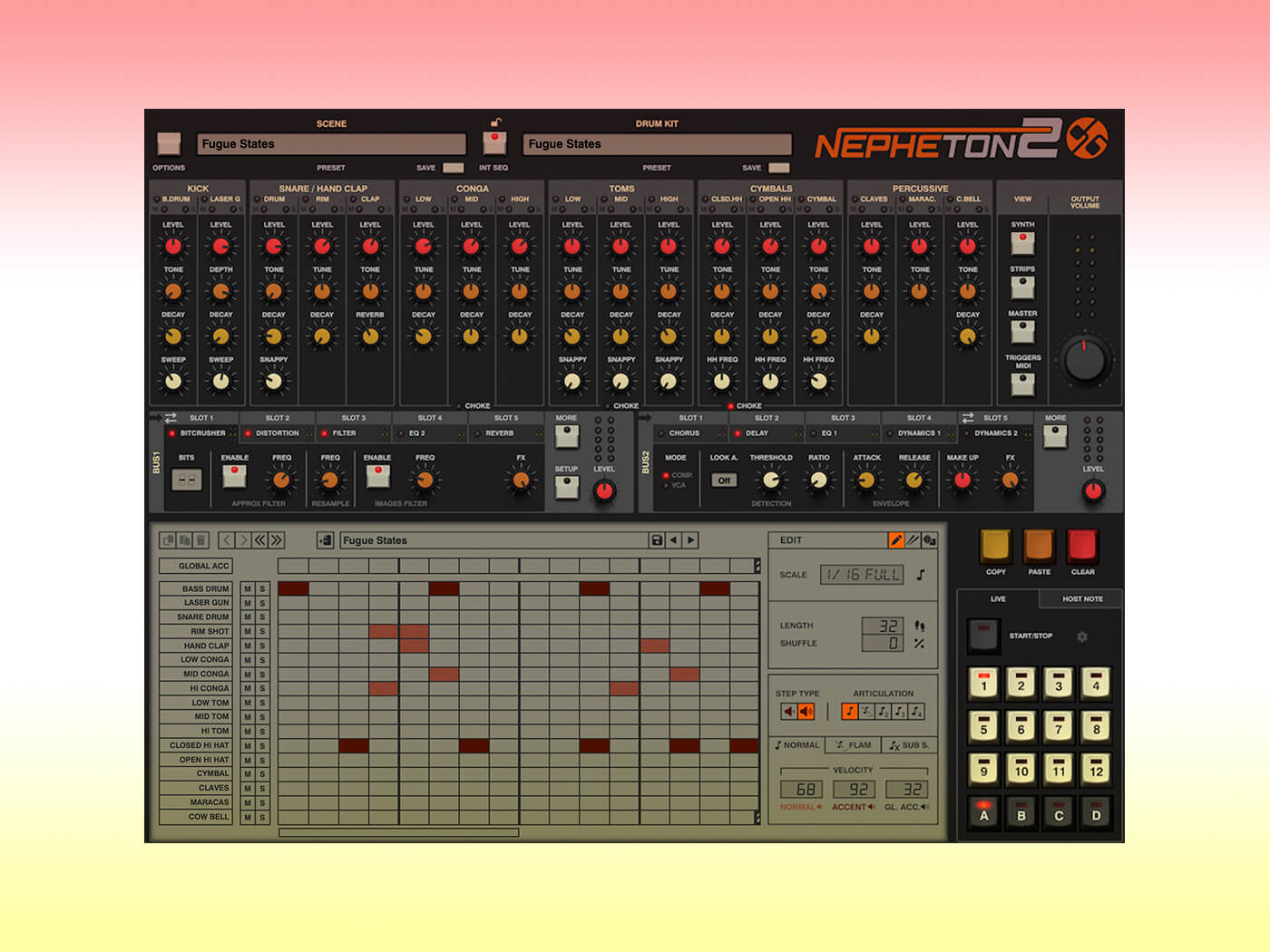
Mapping Nepheton 2
The final tab on the top half of the user interface lets you change the drum mapping to match your controller, DAW, or an external instrument (Nepheton can send MIDI out), and also create audible trigger pulses akin to a feature on the original 808 units.
Other notable additions include separate real-time and offline quality settings (a welcome feature on any plugin), and MIDI learn, which can be setup when you right click on any control. Similarly, this is how you set up parameters for automation in your host. When you want to automate a parameter you right click on it and this makes it visible in the DAW. As Nepheton has hundreds of potential parameters, you have to choose which ones you want your DAW to see. It takes a little extra thought, but it’s a reasonable workaround that’s better than scrolling through an enormous list.
Nepheton 2’s Sequencer
With the sound generation section taken care of, we should move on to the sequencer, which takes up the bottom portion of the screen.
This has seen a dramatic improvement over the previous version, as you can now see sequencer lanes for all 17 sounds in a single grid, greatly speeding up programming. You have various options for copying, pasting and moving patterns of up to 64 steps. There are also options to add accents, swing, and flams or fast rolls, so it’s easy to program those signature trap hi-hat edits. If you want to, you can choose to tap in patterns live, and there’s even a fairly comprehensive randomise function that lets you choose which lanes to change and how complicated the generated patterns should be.
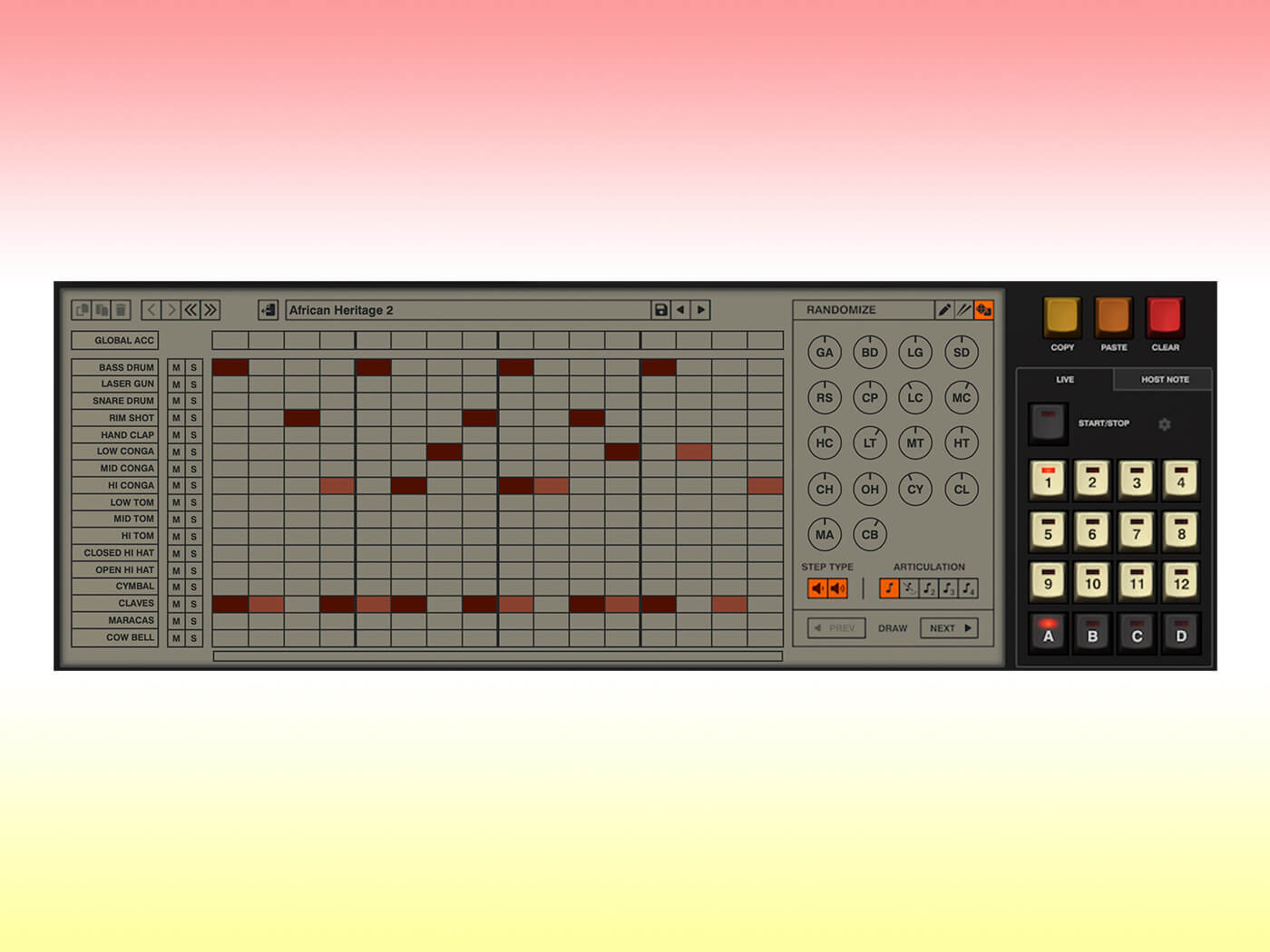
To the right of the sequencer there’s a Song section that lets you save four banks of 12 patterns, which can be performed live or triggered by MIDI. If you’d prefer to refine the edit in the piano roll then you can simply drag and drop the MIDI pattern to your DAW and switch off the sequencer, which also shrinks the interface down to keep things streamlined. Alternatively, you can drag and drop patterns between instances of Nepheton. Overall it’s a solid sequencer that makes programming a relatively quick affair.
Lighting up
It’s worth mentioning that some of the effects, functions and mute/solo buttons are activated by clicking on small LED-like buttons. This is a touch fiddly, depending on how large you set the resizable window, but it’s something that you get used to fairly quickly. One nice touch, though, is the way that there are several places throughout the layout that you can either select a certain sound, or switch on mute/solo. If you’re working in the step sequencer, for instance, then it has its own mute and solo buttons next to each lane so you don’t have to move your cursor around as much. It’s a small thing, but it goes to show how much care and attention have gone into refining the workflow.
There’s a large collection of well-programmed presets that can be accessed from a browser with a search function, favourites and tagging. You can actually save and load separate presets for the Scene (which covers the whole plugin), the Drum Kit (the sounds only), the master effects settings, and the patterns. However, it seems like a missed opportunity not to provide presets for the excellent effects buses.

A king is born?
The CPU usage can get a touch high when running in full quality with all the effects, but Nepheton has the benefit of a much smaller high-def footprint than some sample-based alternatives. Our previous go-to was Wave Alchemy’s excellent Revolution Kontakt instrument, but the added flexibility afforded by the synth engines here means it might have been superseded.
The complexity of the effects and routing is not for the faint of heart, but it’s worth investing some time into as it’s at the core of what makes Nepheton stand out from the crowd. It helps to give the familiar 808 sound much needed versatility along with a modern freshness. Sure, you can craft standard 808 sounds and beats, but if you’re looking for something a little more edgy, then Nepheton can also get creative, and it sounds incredible when doing so.
Key features
- Virtual 808 drum machine
- 32-/64-bit Windows, 64-bit Mac (VST3, VST3, AU, AAX)
- 17 Synthesised percussion instruments
- Dedicated channel strip for every sound
- 2 flexible effects buses (distortion, bitcrush, chorus, delay, reverb, filter, 2 x EQ & 2 x dynamics)
- Master effects with 3-band compressor, and limiter with soft clipping
- Over 1200 presets for Scene, Drum Kit, Pattern and master effects
- 16 stereo outputs for multi-output routing in DAW
- 64-step sequencer with randomisation
- Per-step flam and substep note fills
- Store and trigger up to 48 patterns
- MIDI drum map editor and audible trigger out sounds
- Resizable user interface